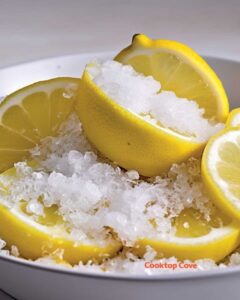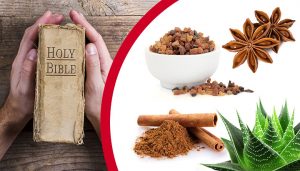by Georgia Lynn
Contributing Writer (RemedyDaily.com)

Put a lemon with salt on a plate, and then place in center of room. This hack will change your life
Life can sometimes become overwhelming, filled with stress and negativity. While there is no magic solution to all of life’s challenges, there are simple and natural methods that can help improve your environment and your mood.
One such method involves using a lemon and some salt. Surprisingly, this age-old trick can have a profound impact on your home and your life. In this article, we will explore how cutting a lemon into four slices with salt and placing them in the center of your room can bring about positive changes.
The Science Behind Lemon and Salt
To understand why this trick works, we need to explore the scientific principles behind the use of lemons and salt to improve the environment:
Lemon’s Antiseptic and Antibacterial Properties:
Lemons are well-known for their natural antibacterial and antiseptic properties, primarily due to their high acidity and the presence of compounds like citric acid and limonene. When lemon slices are placed in a room, they release these compounds into the air, effectively reducing the number of harmful bacteria and microbes present.
Lemon’s Aromatherapeutic Benefits:
The scent of lemon is more than just pleasant; it has been scientifically proven to have mood-enhancing and stress-reducing effects. The aroma of lemon can stimulate the production of serotonin, a neurotransmitter associated with feelings of happiness and well-being. This, in turn, can help reduce stress and anxiety, promoting a more relaxed and positive atmosphere in your home.
Salt’s Ability to Absorb Negative Ions:
Salt has a unique property of being able to absorb negative ions from the surrounding environment. Negative ions are often associated with feelings of discomfort, stress, and lethargy. By placing salt on the lemon slices and dispersing it into the room, you create an environment where the salt absorbs these negative ions, leading to a more balanced and harmonious atmosphere.
Air Purification:
The combination of lemon and salt also acts as a natural air purifier. As the lemon slices release their pleasant fragrance, they effectively mask unpleasant odors, making the room smell fresh and clean. Additionally, the antibacterial properties of lemon help in reducing airborne microbes and allergens.
The Simple Steps
To harness the benefits of this simple yet effective trick, follow these steps:
Step 1: Gather your materials
One fresh lemon
A small plate
A pinch of salt
A knife to cut the lemon
Step 2: Cut the lemon into four slices
Use the knife to cut the lemon into four equal slices. Be careful not to cut yourself, as lemons can be slippery.
Step 3: Sprinkle salt on the lemon slices
Take a pinch of salt and sprinkle it evenly on each lemon slice. The salt will help activate the lemon’s purifying properties.
Step 4: Place the lemon slices in the center of your room
Find a central location in your room and arrange the lemon slices on the plate. Ideally, this should be a spot where you spend a significant amount of time, such as the living room or bedroom.
The Benefits of Lemon and Salt
Improved Air Quality: Lemons are natural air purifiers. As they release their refreshing scent, they can help eliminate odors and create a more pleasant living environment.
Stress Reduction: The aroma of lemon is known for its calming and mood-enhancing properties. It can help reduce stress and anxiety, creating a more peaceful atmosphere.
Negative Energy Cleansing: Salt is believed to absorb negative energy and ions, making the room feel lighter and more positive. This can be especially beneficial if you’ve been feeling stressed or tense.
Enhanced Focus and Productivity: A clean and fresh environment can boost your concentration and productivity. When your surroundings are clutter-free and pleasant, you may find it easier to stay focused and motivated.
Conclusion
Simple natural remedies like cutting a lemon into four slices with salt and placing them in the center of your room can have a surprisingly positive impact on your life. This easy-to-implement trick can improve air quality, reduce stress, cleanse negative energy, and enhance your overall well-being. Give it a try and see how this ancient practice can bring a refreshing change to your living space and, subsequently, to your life. Remember, it’s often the simplest solutions that can make the most significant difference.
RESOURCES
RemedyDaily.com does not give medical advice, diagnosis, or treatment.


